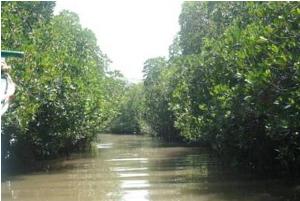 Staff Correspondent :: Mangroves can help protect human lives and property by reducing the impacts of storm surges, the new report exposes. Storm surges – raised sea water levels driven by winds and low pressures – are among the most devastating natural hazards in modern times and their impacts are being increasingly felt, with growing populations and infrastructure in low-lying coastal areas. Climate change may further increase the frequency or intensity of storm surges in some areas.
Staff Correspondent :: Mangroves can help protect human lives and property by reducing the impacts of storm surges, the new report exposes. Storm surges – raised sea water levels driven by winds and low pressures – are among the most devastating natural hazards in modern times and their impacts are being increasingly felt, with growing populations and infrastructure in low-lying coastal areas. Climate change may further increase the frequency or intensity of storm surges in some areas.
Recent cyclones across the Caribbean and the Philippines have served to heighten the urgency for coastal protection and disaster risk reduction. “Most countries are aware of the threat, but the default response is often to look for engineered solutions” said Dr Mark Spalding, senior marine scientist at The Nature Conservancy. “These can be highly effective, but the role of natural solutions should not be overlooked. Mangroves can be effective in reducing waves and storm surges, and can be used alongside other risk reduction measures such as early warning systems and engineered coastal defence structures”.
Mangroves can reduce water levels by up to half a metre for each kilometre of mangrove that the storm surge passes through. This implies that relatively wide mangrove belts will be needed to reduce storm surges. Such wide mangroves belts are still present in many parts of the tropics that are affected by cyclones and storm surges, such as the U.S.A., Bangladesh, India, Indonesia and Australia.
 There is little information on storm surge reduction by mangroves, because it is difficult to measure water levels during cyclones. However, mathematical models suggest that mangroves can significantly reduce flooding from storm surges in some areas. They also indicate that the most dramatic reduction in surge height may be in the front areas of the mangrove – those reached first by the surge itself. Dense mangrove forests, including species with aerial roots, are likely to be more effective at reducing water levels in a surge.
There is little information on storm surge reduction by mangroves, because it is difficult to measure water levels during cyclones. However, mathematical models suggest that mangroves can significantly reduce flooding from storm surges in some areas. They also indicate that the most dramatic reduction in surge height may be in the front areas of the mangrove – those reached first by the surge itself. Dense mangrove forests, including species with aerial roots, are likely to be more effective at reducing water levels in a surge.
“This report shows that conservation and restoration of mangroves in vulnerable coastal areas can contribute to a risk reduction strategy to protect people and their property against inundation and damage,” said Nyoman Suryadiputra, Director of Wetlands International Indonesia. “Moreover, we observe that mangroves help people recover after coastal disasters by providing firewood, building materials and food sources, such as fish and shellfish.”
“Further research is needed to allow us to understand and quantify the coastal defence services provided by mangrove forests against storm surges. Such information is vital if we are to ensure that mangroves are used appropriately in coastal defence”, said lead author of the report Dr Anna McIvor of The Nature Conservancy.




I believe this website contains some rattling wonderful information for everyone . “Laughter is the sun that drives winter from the human face.” by Victor Hugo.
. “Laughter is the sun that drives winter from the human face.” by Victor Hugo.